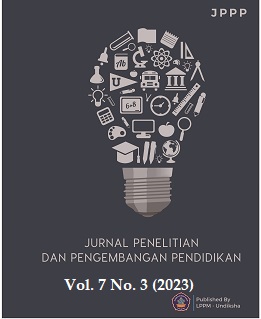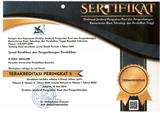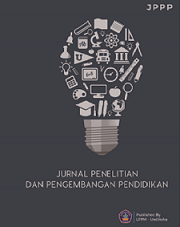Students’ Mathematical Generalization in Solving Numeracy Problems
DOI:
https://doi.org/10.23887/jppp.v7i3.66888Keywords:
Mathematical Generalization, Ability, Real Contex Problems, NumeracyAbstract
Generalization is an important component of mathematical activity and has received increasing attention in school mathematics at all levels. This research aims to analyze junior high school students' mathematical generalization abilities in number pattern material. This research is descriptive research with a qualitative approach. The subjects of this research were 28 junior high school students in the even semester. The students consisted of 12 male students and 16 female students. The data collection method used is the test method. Data analysis in this research was carried out through the stages of reduction, presentation and drawing conclusions on the data obtained. Based on the results of data analysis, it shows that the mathematical generalization ability of junior high school students in number patterns was obtained: (1) 8 students (28%) had high mathematical generalization ability, (2) 15 students (54%) had medium ability, and (3) 5 students ( 18%) have low ability. These findings show that the majority of students have good mathematical generalization abilities, but there are also those who still need further assistance in improving their abilities.
References
Ambussaidi, I., & Yang, Y.-F. (2019). The Impact of Mathematics Teacher Quality on Student Achievement in Oman and Taiwan. International Journal of Education and Learning, 1(2), 50–62. https://doi.org/10.31763/ijele.v1i2.39. DOI: https://doi.org/10.31763/ijele.v1i2.39
Anderson, J. R., Zhang, Q., Borst, J. P., & Walsh, M. M. (2016). The discovery of processing stages: Extension of Sternberg’s method. Psychological Review, 123(5), 481–509. https://doi.org/10.1037/rev0000030. DOI: https://doi.org/10.1037/rev0000030
Anggito, A., & Setiawan, J. (2018). Metode Penelitian Kualitatif. CV Jejak.
Aristawati, F. A., Budiyanto, C., & Yuana, R. A. (2018). Adopting Educational Robotics to Enhance Undergraduate Students’ Self-Efficacy Levels of Computational Thinking. Journal of Turkish Science Education, 15, 42–50. https://doi.org/10.12973/tused.10255a.
Budiyono. (2017). Pengantar metodelogi penelitian pendidikan (M. P. D. Sudiyanto & Ed) (eds.)). UNS Press.
Callejo, M. L., & Zapatera, A. (2017). Prospective primary teachers’ noticing of students’ understanding of pattern generalization. Journal of Mathematics Teacher Education, 20(4), 309–333. https://doi.org/10.1007/s10857-016-9343-1. DOI: https://doi.org/10.1007/s10857-016-9343-1
Chua, B. L., & Hoyles, C. (2014). Generalisation of linear figural patterns in secondary school mathematics. The Mathematics Educator, 15(2), 1–30. https://repository.nie.edu.sg/handle/10497/18888.
Dani, S., Pujiastuti, H., & Sudiana, R. (2017). Pendekatan Realistic Mathematics Education Untuk Meningkatkan Kemampuan Generalisasi Matematis Siswa. Jurnal Penelitian Dan Pembelajaran Matematika, 10(2), 182–193. https://doi.org/10.30870/jppm.v10i2.2043. DOI: https://doi.org/10.30870/jppm.v10i2.2043
Dinarti, S., & Qomariyah, U. N. (2022). Analisis strategi siswa sekolah dasar dalam memecahkan masalah generalisasi pola ditinjau dari gaya kognitif. AKSIOMA: Jurnal Matematika Dan Pendidikan Matematika, 13(2), 278–293. http://journal.upgris.ac.id/index.php/aksioma/article/view/12517.
Domike, G. C., & Odey, E. O. (2014). An evaluation of the major implementation problems of primary school curriculum in cross river state, Nigeria. American Journal of Educational Research, 2(6), 397–401. https://doi.org/10.12691/education-2-6-12. DOI: https://doi.org/10.12691/education-2-6-12
Fiangga, S., M. Amin, S., Khabibah, S., Ekawati, R., & Rinda Prihartiwi, N. (2019). Penulisan Soal Literasi Numerasi bagi Guru SD di Kabupaten Ponorogo. Jurnal Anugerah, 1(1), 9–18. https://doi.org/10.31629/anugerah.v1i1.1631. DOI: https://doi.org/10.31629/anugerah.v1i1.1631
Gal, I., Grotlüschen, A., Tout, D., & Kaiser, G. (2020). Numeracy, adult education, and vulnerable adults: a critical view of a neglected field. ZDM, 52(3), 377–394. https://doi.org/10.1007/s11858-020-01155-9. DOI: https://doi.org/10.1007/s11858-020-01155-9
Hadi, S., & Novaliyosi, N. (2019). TIMSS Indonesia (trend in Indonesia mathematic and science study). Prosiding Seminar Nasional & Call For Papers, 0(0). http://jurnal.unsil.ac.id/index.php/sncp/article/view/1096.
Hayuningrat, S., & Rosnawati, R. (2022). Development of learning tools based on realistic mathematics approach that oriented to high school students’ mathematical generalization ability. Jurnal Riset Pendidikan Matematika, 9(2). https://doi.org/10.21831/jrpm.v9i2.52197. DOI: https://doi.org/10.21831/jrpm.v9i2.52197
Iswara, H. S., Ahmadi, F., & Ary, D. Da. (2022). Numeracy Literacy Skills of Elementary School Students through Ethnomathematics-Based Problem Solving. Interdisciplinary Social Studies, 2(2), 1604–1616. https://doi.org/10.55324/iss.v2i2.316. DOI: https://doi.org/10.55324/iss.v2i2.316
Jeannotte, D., & Kieran, C. (2017). A conceptual model of mathematical reasoning for school mathematics. Educational Studies in Mathematics, 96(1), 1–16. https://doi.org/10.1007/s10649-017-9761-8. DOI: https://doi.org/10.1007/s10649-017-9761-8
Joanna, J. (2017). The strategies of using a special kind of number patterns in different stages of education. Educational Research and Reviews, 12(12), 643–652. https://doi.org/10.5897/ERR2017.3244. DOI: https://doi.org/10.5897/ERR2017.3244
Karabulut, A., & Özmen, E. R. (2018). Effect of “understand and solve!” strategy instruction on mathematical problem solving of students with mild intellectual disabilities. International Electronic Journal of Elementary Education, 11(2), 77–90. https://doi.org/10.26822/iejee.2018245314. DOI: https://doi.org/10.26822/iejee.2018245314
Magiera, M. T., & Zambak, V. S. (2021). Prospective K-8 teachers’ noticing of student justifications and generalizations in the context of analyzing written artifacts and video-records. International Journal of STEM Education, 8(1). https://doi.org/10.1186/s40594-020-00263-y. DOI: https://doi.org/10.1186/s40594-020-00263-y
Malloy-Weir, L. J., Schwartz, L., Yost, J., & McKibbon, K. A. (2016). Empirical relationships between numeracy and treatment decision making: A scoping review of the literature. Patient Education and Counseling, 99(3), 310–325. https://doi.org/10.1016/j.pec.2015.10.002. DOI: https://doi.org/10.1016/j.pec.2015.10.002
Mata-Pereira, J., & da Ponte, J. P. (2017). Enhancing students’ mathematical reasoning in the classroom: teacher actions facilitating generalization and justification. Educational Studies in Mathematics, 96(2), 169–186. https://doi.org/10.1007/s10649-017-9773-4. DOI: https://doi.org/10.1007/s10649-017-9773-4
Miller, T. (2018). Developing numeracy skills using interactive technology in a play-based learning environment. International Journal of STEM Education, 5(1). https://doi.org/10.1186/s40594-018-0135-2. DOI: https://doi.org/10.1186/s40594-018-0135-2
Mulenga, E. M., & Marbán, J. M. (2020). Prospective teachers’ online learning mathematics activities in the age of COVID-19: A cluster analysis approach. Eurasia Journal of Mathematics, Science and Technology Education, 16(9), 1–9. https://doi.org/10.29333/EJMSTE/8345. DOI: https://doi.org/10.29333/ejmste/8345
Pittig, A., Treanor, M., LeBeau, R. T., & Craske, M. G. (2018). The role of associative fear and avoidance learning in anxiety disorders: Gaps and directions for future research. Neuroscience & Biobehavioral Reviews, 88, 117–140. https://doi.org/10.1016/j.neubiorev.2018.03.015. DOI: https://doi.org/10.1016/j.neubiorev.2018.03.015
Rosnaeni, R. (2021). Karakteristik dan Asesmen Pembelajaran Abad 21. Jurnal Basicedu, 5(5), 4341–4350. https://doi.org/10.31004/basicedu.v5i5.1548. DOI: https://doi.org/10.31004/basicedu.v5i5.1548
Saefurohman, S., Maryanti, R., Azizah, N. N., Al Husaeni, D. F., Wulandary, V., & Irawan, A. R. (2021). Efforts to increasing numeracy literacy of Elementary School Students through Quiziz learning media. ASEAN Journal of Science and Engineering Education, 1(3), 11–18. https://doi.org/10.17509/ajsee.v3i1.38570
Sapa’at, A. (2020). Pengembangan Keterampilan Berpikir Matematis Melalui Pembelajaran Matematika. Jurnal Pendidikan Dompet Dhuafa, 10(1), 15–19. http://jurnal.pendidikandd.org/index.php/JPD/article/view/192.
Setiawan, Y. E., Purwanto, P., N., I., & Sisworo. (2020). Generalization strategy of linear patterns from field-dependent cognitive style. Journal on Mathematics Education, 11(1), 77–94. https://doi.org/10.22342/jme.11.1.9134.77-94. DOI: https://doi.org/10.22342/jme.11.1.9134.77-94
Sriraman, B. (2003). Mathematical giftedness, problem solving, and the ability to formulate generalizations: The problem-solving experiences of four gifted students. Journal of Secondary Gifted Education, 14(3), 151–165. https://doi.org/10.4219/jsge-2003-425. DOI: https://doi.org/10.4219/jsge-2003-425
Suhirman, Y., Muliadi, A., & Prayogi, S. (2020). The effect of problem-based learning with character emphasis toward students’ higher-order thinking skills and characters. International Journal of Emerging Technologies in Learning, 15(6), 183–191. https://doi.org/10.3991/IJET.V15I06.12061. DOI: https://doi.org/10.3991/ijet.v15i06.12061
Umrati, H. W. (2020). Analisis data kualitatif teori konsep dalam penelitian pendidikan. Sekolah Tinggi Theologia Jaffray.
Downloads
Published
How to Cite
Issue
Section
License
Copyright (c) 2023 Titania Putri Naraswari, Tri Atmojo Kusmayadi, Laila Fitriana

This work is licensed under a Creative Commons Attribution-ShareAlike 4.0 International License.
Authors who publish with the Jurnal Penelitian dan Pengembangan Pendidikan agree to the following terms:
- Authors retain copyright and grant the journal the right of first publication with the work simultaneously licensed under a Creative Commons Attribution License (CC BY-SA 4.0) that allows others to share the work with an acknowledgment of the work's authorship and initial publication in this journal.
- Authors are able to enter into separate, additional contractual arrangements for the non-exclusive distribution of the journal's published version of the work (e.g., post it to an institutional repository or publish it in a book), with an acknowledgment of its initial publication in this journal.
- Authors are permitted and encouraged to post their work online (e.g., in institutional repositories or on their website) prior to and during the submission process, as it can lead to productive exchanges, as well as earlier and greater citation of published work. (See The Effect of Open Access)








